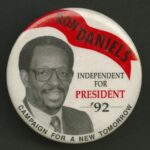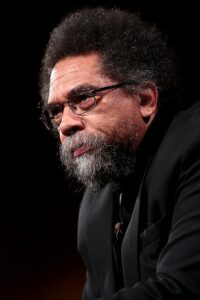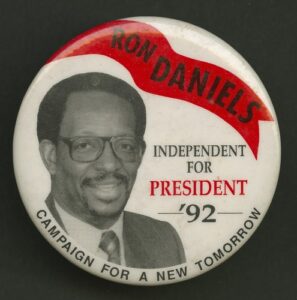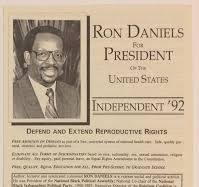Cornel West for President? – Part 7 – Ron Daniels for President- 1992

 Cornel West announced in early June that he was running for president of the United States as the candidate for the People’s Party and then as aspiring to be candidate of the Green Party. Now he has formed a new Justice for all Party on which he will run.
Cornel West announced in early June that he was running for president of the United States as the candidate for the People’s Party and then as aspiring to be candidate of the Green Party. Now he has formed a new Justice for all Party on which he will run.
This series of articles explores the experience of Black political candidates for the nation’s highest offices.. In Part 1 of this article, we looked at the reaction of the left to West’s candidacy. In Part 2 we turn to look at the experience of four Black presidential candidates in 1968. In Part 3 we examined the campaign of Shirley Chisholm in 1972. In Part 4 of the series we recalled the experience of Angela Davis, twice candidate for vice-president. In Part 5 we looked at the experience of Clifton Berry in 1964. Part 6 adealt with t Rev. Jesse Jackson’s two campaigns in 1984 and 1988. Here in Part 7, we discuss Ron Daniels 1992 campaign.
 Ron Daniels decided to run for president in 1992 after his experience as national director of the Rainbow Coalition during Jesse Jackson’s 1988 presidential campaign. Like many others, he believed that after Jacobson’s two remarkable campaigns, the Rainbow Coalition ht had supported Jackson could lead progressive forces and open a new progressive era in America. When Jackson effectively shut down the Rainbow, Daniels was disappointed and decided to run for president himself, hoping to have the support of the Rainbow forces and to be able to continue and dedevelop its work. But Daniels could not revive the Rainbow and his campaign failed to catch fire, despite his progressive civil rights, labor, and international agenda.
Ron Daniels decided to run for president in 1992 after his experience as national director of the Rainbow Coalition during Jesse Jackson’s 1988 presidential campaign. Like many others, he believed that after Jacobson’s two remarkable campaigns, the Rainbow Coalition ht had supported Jackson could lead progressive forces and open a new progressive era in America. When Jackson effectively shut down the Rainbow, Daniels was disappointed and decided to run for president himself, hoping to have the support of the Rainbow forces and to be able to continue and dedevelop its work. But Daniels could not revive the Rainbow and his campaign failed to catch fire, despite his progressive civil rights, labor, and international agenda.
Child of a Black Working Class Family
Ron Daniels refers to himself as “the son of a coal miner and a coal miner’s daughter.”[i] His mother, Wealtha Marie White grew up in the coal mining communities of Beckley, West Virginia during the Great Depression. She married William Daniels, a man twenty years her senior, who had grown up in Talbot County, Georgia and gone to Beckley in search of work. There Bill Daniels became a union steward in the United Mine Workers when John L. Lewis was still the head of the union. He was also active in the NAACP. When Ron Daniels was still a boy, his parents moved to Youngtown, Ohio where his father became a steelworker and a member of the Unite Steel Workers. With his savings, Bill and Wealtha also opened up Daniels’ Grocery and Confection, or the “Colored Store,” a small store. The young Ron Daniels also lived at times in Pittsburgh, Pennsylvania. Whether in Youngstown or Pittsburgh, he lived in def facto segregated communities, in what he called the “dark ghettos.”
His parents divorced when he was nine and he then lived with his mother in Pittsburgh where as a single mother she raised her four children. At the age of 12, Ron Daniels was baptized Ebenezer Baptist Church, joined the Baptist Young People’s Union, and was the youngest delegate to the state Baptist convention held in Philadelphia. A military veteran in his neighborhood organized a group in Pittsburgh called the Cadet Corps that Daniels replicated in Youngtown. “…a paramilitary youth organization, which showcased my leadership potential and laid the foundation for my eventual rise as a civil rights/social justice scholar/activist/leader.” The group of serious young men caught people’s attention and Daniels was noticed as, “…a young man that some said might one day be the first Black president, Ron Daniels.”
Civil Rights and Black Power Activist
Still an adolescent in high school, Daniels became an NAACP youth leader, and later founded the college chapter at Youngstown State University. It was his involvement in the NAACP that made it possible for him to attend the March on Washington in 1963. After graduating from college with a B.A. in History, Daniels went to Graduate School of Public Affairs (later the Rockefeller School of Public Affairs and Policy) to pursue a master’s degree in political science. It was there that he met Black power activists from new movements and organizations, leading him to write his master’s thesis “Black Power: An Ideology on Anvil.”
Daniels writes, “I returned to Youngtown transformed. I had left an NAACP leader committed to its ‘integrationist’ approach. I returned as a defender of Black Power with its manifestations of Black consciousness, historical/cultural awareness,
institution-building and empowerment.” In Youngstown, Daniels now began to organize community organizations, such as Unity, Cooperation, and Action, Freedom, Inc., the Uhuru Center and others. He became a leader of the Midwest Regional Coalition, Federation of the Pan -African Education Institutions. In the course of all of this this activity, he met activists from CORE and SNCC and developed relations with them
The National Black Political Convention held on March 10–12, 1972 in Gary, Indiana created the National Black Political Assembly, originally chaired by the triumvirs Congressman Charles C. Diggs, Gary Mayor Richard G. Hatcher, and poet Amir Baraka (LeRoi Jones) of New Jersey. In 1974 Daniels was elected its president. The convention led many African Americans throughout the country to run for political office, Ron Daniels among them. In 1977, Daniels ran for mayor of Youngstown, but despite the support of congressmen Walter Fauntroy and Ron Dellums, Daniels lost. In the 1980s he became involved with the National Committee for Independent Political Action with his associate, civil rights attorney Arthur Kinoy.
 Presidential Campaign
Presidential Campaign
As he writes regarding his movement and political organizing in Ohio, “And it was a body of work that would elevate me to the status of a national/international leader, recruited to become Executive Director of the National Rainbow, Deputy Campaign Manager for Rev. Jesse Jackson’s 1988 presidential bid… ” When the Jackson campaign ended and the Rainbow was demobilized, Daniels attempted to pick up the torch, announcing his candidacy for president at a news conference October 14, 1991. He chose as his running mate Asiba Tupahache a woman who was a Matinecoc Native American activist from New York.
Daniels ran on the principles he had developed over the previous decades: Black civil rights and improvements in the Black economic, social, and political situation, support for an independent political party, and for solidarity with Blacks in Africa and throughout the diaspora. As he said, however, while white political parties were exclusive, his model was a politics of inclusion in which all would benefit from the promotion of progressive values and the passing of progressive legislation.
On Election Day, Democrat Bill Clinton won with 44,909,889 or 43% of the vote; Republican George w. Bush received 39,104,550 or 37%; and conservative independent Ross Perot got 19,743,821 or 18.9%. That was also the year that Ralph Nader first entered a presidential contest, though he appeared on the ballot in only a couple of states and received only a few thousand votes. Daniels The Daniels-Tupahache ticket received 27,949 votes for 0.03%; they may also have received as many as 20,000 write-in votes in various states. They won no delegates.
As Bill Fletcher, Jr. commented, “Daniels overestimated how well he was known and the support he would have from the former Jesse Jackson and Rainbow supporters.”
“Pragmatic Progressive’
After his 1992 campaign, Daniels remained active as an organizer, speaker, and writer involved in the Black movement in America and in solidarity campaigns with peoples in Africa and the diaspora. He characterizes himself as a “pragmatic progressive” who, while he works for independent political action, is not necessarily opposed to campaigns in the Democratic Party, such as those of Jesse Jackson and Bernie Sanders. Regarding the campaign of fellow Black progressive Cornel West, Daniels says, “I hope he will make some strong demands and then drop out of the race so that we can deliver a crushing blow to the Maga [Trump] Republicans.”
[i] The account of Daniels’ life comes from a conversation with him in February 2024 and from his book Still on This Journey: The Vision and Mission of Dr. Ron Daniels (n.p.: State of the Black World Press, 2019), pp. 1-55.